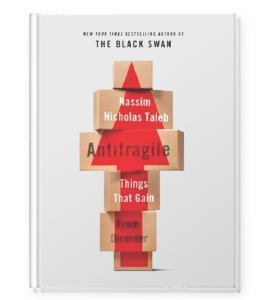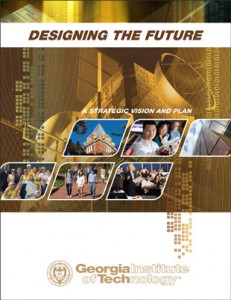 Something different this month: a book review.
Something different this month: a book review.
I read a lot of books… a couple of hundred per year. Some are serious, some are fluff, some are instantly forgettable. But occasionally, to quote Francis Bacon, “Some books are to be tasted, others to be swallowed, and some few to be chewed and digested… to be read wholly, and with diligence and attention.” That last category describes Nassim Taleb’s newest book, “Antifragile.”
Taleb is famous for his earlier works “Fooled by Randomness” and “The Black Swan.” This is a sequel of sorts, but stands on its own… and makes a different point.
Taleb starts by noting that there is no word for “the opposite of fragile.” (Not just in English. He checked 21 other languages.)
“Of course there is!” you say. “Lots of words: robust, resilient, strong…”
No. Take the concepts in turn. Something fragile — like a teacup — responds to a shock (physical, emotional, financial…) by shattering: a major negative consequence that is difficult or impossible to repair. Something strong — like a rock — can ignore the shock that shatters a teacup. Something resilient — like a rubber ball — may deform, but will quickly return to its original state, none the worse for wear.
But certain things can actually undergo certain levels of shock and actually improve. It’s like a teacup that gets stronger if you drop it.
What on Earth reacts like that?
Living things. If you lift more weight, you become capable of lifting more weight. If you learn new mathematics, you become capable of learning more mathematics. If you play baseball, you become capable of playing better baseball. If you get a smallpox vaccine, you become capable of fighting off a more serious smallpox infection.
Or networks of living things (communities, enterprises, economies, religions…). Schumpeter called it “creative destruction.” But destruction isn’t required. An organization that has survived crises (work stoppages, supply chain disruptions, financial overreach) is simply more capable of competing effectively than an organization that has not. Of course, what’s not visible is the survivorship bias: the organizations that did not survive are not competing anymore.
Obviously, there are limits. No matter how much time I spend in the gym, I won’t be able to lift 2000 pounds. And no matter how efficient my supply chain, my company won’t survive if General Electric chooses to make a direct target of me. But, within surprisingly large ranges, the concept of “antifragility” crops up again and again in all aspects of life.
In Taleb’s words, “That’s what makes entrepreneurship work: the fragility of entrepreneurs and their necessarily high failure rate.” And it’s not just high-tech entrepreneurship. Take restaurants: Any particular new restaurant has a high failure rate. In Taleb’s words, it is “fragile.” But the restaurant sector as a whole is “antifragile” since the surviving restaurants (in that neighborhood, or city, or region) observe the failures, and adapt accordingly. New restaurants come and new restaurants go, but there’s never an overall shortage of restaurants to eat at.
After identifying the trait of antifragility, Taleb goes on to analyze what it means. In anecdotes and in mathematical equations, he repeatedly makes the point that we can adjust our actions to optimize the impact of random variation, even if we don’t understand the underlying mechanism. For example:
Lifting weights increases your muscle mass. In the past they used to say that weight lifting caused the “micro-tearing of muscles,” with subsequent healing and increase in size. Today some people discuss hormonal signaling or genetic mechanisms; tomorrow they will discuss something else. But the effect has held forever and will continue to do so.
In other words, even though we don’t actually understand how lifting weights increases muscle mass, it’s sufficient to know that it does. He gives similar examples for companies and for financial speculators… knowing what can be far more important than why.
That’s isn’t always a comforting message for academics, and for others who pride themselves on knowing “why.” But the flying bird doesn’t care about theories of aerodynamics, it just flies.
I’m fortunate enough to have met Nassim Taleb several times… I’m flattered that I’m one of the 98 people he follows on Twitter (certainly asymmetric as compared to his 70,000 followers!). I described my first encounter with him as “conversing with a swarm of butterflies. A swarm of glittering, hyper-intelligent cyborg butterflies. Who aren’t quite sure whether to take over the Earth or migrate to another star system.”
This book reads the same way… some reviews have criticized it for suffering from ADHD. But I loved the style, since it forced me to put the book down and think every few pages. (This is not the book to toss into your bag before leaving for the beach this summer. For that, I recommend the Grimnoir Trilogy.)
The Antifragile University
 There’s far more to this book than I can summarize in 1000 words. But I kept returning to a thought while reading it: “What would an antifragile university look like? And how can we turn Georgia Tech into the first one?”
There’s far more to this book than I can summarize in 1000 words. But I kept returning to a thought while reading it: “What would an antifragile university look like? And how can we turn Georgia Tech into the first one?”
I suspect that Taleb would tell me it’s unlikely. In his words, “Education is an institution that has been growing without external stressors; eventually, the thing will collapse.” He would certainly tell us that the answer is not an updated strategic plan: “There is no evidence that strategic planning works—we even have evidence against it.”
I was peripherally involved in writing our own current Strategic Plan, and my boss was the editor. Hundreds of very bright people around campus spent an aggregate of thousands of hours developing it. And we published it to great fanfare in 2010. It has five Goals, ten Objectives, and sixteen Strategies.
And we completely missed MOOCs.
Which, two years later, were the hottest topic in higher education.

Additional centralized planning wouldn’t have helped us with MOOCs. What did help us was the fragmented, decentralized nature of power at Georgia Tech, where one college dean was able to launch our online Master’s degree in Computer Science without endless wrangling in the Academic Senate and more-endless argumentation among the Board of Regents. So Georgia Tech is rightfully seen as one of the leaders in figuring out what MOOCs will mean to the research university of the 21st century. Not because our centralized planning was smarter than the other guy’s centralized planning. But because of an inherently antifragile response to changing conditions… “stressors.”
Maybe we recognized the stressors faster than the other guys. Certainly, we reacted faster than they did. (And, so maybe, the “antifragile university” isn’t as unlikely as Taleb would think.)
How do we do more of that? And how do we build fewer fragile networks that shatter at first impact with reality?
And, in EI2, how do we help our clients — startups, manufacturers, hospitals, communities — do that?
I suspect that variations on this question are going to become more and more important over the next few years. Taleb’s book is a good way to start thinking about answers in a different way. I recommend it.

[…] Stephen Fleming: Antifragile […]